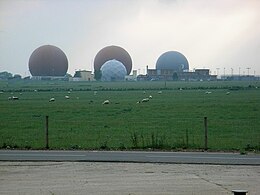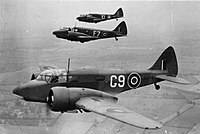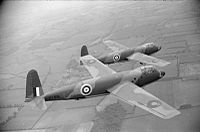RAF Croughton
| RAF Croughton | |
 | |
|---|---|
| Code | |
| County | Northamptonshire |
 | |
| Owner | Ministry of Defence |
| Location | SP558324 51°59’17"N, 1°11’15"W |
| Website | |
RAF Croughton is a Royal Air Force station which is currently a United States Air Force communications station, in Northamptonshire, south-east of the village of Croughton at the southernmost edge of the county. The station is home to the 422nd Air Base Group and operates one of Europe's largest military switchboards and processes approximately a third of all American military communications in Europe.
History
Early years
The airfield was built in 1938, and was originally known as 'Brackley Landing Ground' until 1940 when it became RAF Brackley.[1] In July 1941 the name changed again and the station became RAF Croughton.[1]
The base consisted of 694 acres, consolidated from three farms. Three grass runways with concrete taxiways dominated the high ground with the tower and other infrastructure buildings along the north side of the station and the slope leading up to the runways. In June 1940 the station became a satellite for RAF Upper Heyford for No. 16 Operational Training Unit (No. 16 OTU) to provide the unit with extra airfield space for night-flying training.[1]
Much of this training was for Commonwealth pilots – Canadians, South Africans, Australians, and New Zealanders – on Handley Page Hampdens, Bristol Blenheims, and Vickers Wellington bombers. The unit fell under the operational control of the newly formed No. 7 Group RAF of RAF Bomber Command.[1]
Second World War
In September 1940 the Air Ministry decided that certain stations would be designated as emergency airfields. These stations would give assistance to any operational aircraft returning damaged or with engine problems. The Station Commander at RAF Upper Heyford received one of these orders. RAF Brackley (Croughton) would remain open with its flare paths illuminated irrespective of enemy activity in the area. This meant that RAF Brackley along with other emergency airfields attracted additional enemy night attacks. Added to this accepted high risk was the fact that RAF Brackley was a training airfield. During the war both sides considered it worthwhile to attack and disrupt training programmes. Because training fields and aircraft were lightly defended, they made for easier targets. For these reasons, it was not uncommon for the station or training crews conducting night training to receive the attention of the Luftwaffe.[1]
While the station remained a satellite for RAF Upper Heyford and No. 16 OTU until July 1942 and even partially re-equipped with Wellington bombers, its future had already changed. No. 23 Squadron of RAF Flying Training Command (FTC) was desperately seeking a suitable airfield to re-house its No. 1 Glider Training School (No. 1 GTS).[1]
Its then home was a small airfield at RAF Thame in Buckinghamshire and FTC felt it inadequate for glider training. Several airfields in the near vicinity made the short list, but RAF Croughton became the new home for the gliders. On 19 July 1942, No. 1 GTS began to move in and by 1 August 1942 they were settled into their new home. During this training Hawker Hectors, North American Harvards, and Miles Masters pulled General Aircraft Hotspur gliders, while Douglas Dakotas pulled the larger Airspeed Horsa gliders.[1]
With this new mission came a far stricter training regime and standards than that usually found at an RAF training station. The reason for this was the dual roles required of the glider pilots. They would receive twelve weeks of basic flying training, before moving to one of the GTS. Training at the GTS took another twelve weeks. From there they would move onto their operational units. In addition to flying the gliders, pilots had to be as highly trained and disciplined as infantry troops. This way they could make a positive contribution to the battle after landing in the assault areas. However, they would only remain in the assault area until their recovery. By the end of 1942 the RAF thought it had enough trained glider pilots, at least for foreseeable operational need. There was now a large number of trained glider pilots and this led to its own problems and another change in the station's mission.[1]

As the last class passed out of RAF Croughton on 24 March 1943, the glider school closed down. It continued to be a training base, but now it was a satellite for Kidlington in Oxfordshire where the No. 20 (Pilots) Advanced Flying Unit RAF (AFU) gave refresher or advanced training to pilots. Established in 1942, the AFUs provided refresher courses to pilots trained overseas under the British Commonwealth Air Training Plan. It also gave newly qualified pilots experience with flying in British weather and handling heavier aircraft. With the No. 20 AFU, this meant the Airspeed Oxford. Pilots training with these aircraft knew they were destined for either Bomber or Coastal Command.[1]
On 15 April 1943 No. 1538 (Beam Approach Training) Flight RAF (No.15 BATF) formed at RAF Croughton and added to the station's training mission. Before this many of the pilots training with No. 20 AFU received their Beam Approach Training at RAF Feltwell. Both No. 1538 BATF and No. 20 AFU remained at RAF Croughton until 18 October 1944 when the airfield returned to Flying Training Command. On this date No. 1538 BATF disbanded and No. 20 AFU retired to Kidlington.[1]
RAF Flying Training Command needed the station to reform No. 1 Glider Training School. The decision to reopen glider training came about when the army finally agreed that the glider pilots should be RAF. From the beginning both the RAF and Army had differing opinions as to who should pilot the gliders. The Army felt the Glider Pilot Regiment was an elite force and that the pilots should be from the Army or at the very least trained to the same standard. The Army even rejected a proposal from the RAF to have a RAF pilot sit in the second pilot or co-pilot seat. This changed after Operation Market Garden.[1]

During the Arnhem portion of that operation 460 glider pilots were either killed or captured, with another 150 wounded. The Army agreed to let the RAF help fill the vacancies in the Glider Pilot Regiment. Of the planned 1,000 trained glider pilot target figure, to be reached by April 1945, the RAF proposed to fill 500. No. 1 GTS arrived at RAF Croughton on 1 November 1944. Training continued until after the war and even included the addition of a Glider Instructor Flight.[1]
During August 1945 No. 1 GTS came under the command of No. 21 Heavy Glider Conversion Unit RAF at RAF Brize Norton. Flying and training ceased on 25 May 1946. With No. 1 GTS leaving RAF Croughton, its remaining aircraft, Hotspurs and Masters worth preserving, moved to No. 3 GTS at RAF Wellesbourne Mountford.[1]
Postwar – United States Air Force use
From 1947 to 1950 the Station remained fairly quiet and forgotten except for its occasional use as an ammunitions store. That all changed towards the end of 1950 when the USAF took over the station when the 1969th Communications Squadron at RAF South Ruislip formed a detachment at RAF Croughton. This began RAF Croughton's new communications mission. Over the next several decades the units stationed at RAF Croughton changed many times, but the mission remained communications.[1]
In 1955 this detachment became the 1230th Airways and Air Communications Service Squadron (AACS). As part of the establishment of the Air Force Communication Service as a separate major command, Air Force Communications Command, in 1961, the 1230 AACS redesignated to become the 2130th Communications Squadron (CS). In just over ten years the mission and unit grew to the point that it needed to redesignate to the 2130th Communications Group (CG). By 1977, the 2130 CG controlled USAF communication resources from as far south as Cornwall and as far north as Keflavík in Iceland.[1]
The beginning of 1993 saw several big changes for RAF Croughton. Most of these had to do with mission support. With the projected inactivation of the 20th Fighter Wing at RAF Upper Heyford and closure of that station the 2130 CG redesignated to the 630th Communications Squadron. This new squadron functionally aligned under the 100th Communications Group (CG) at RAF Mildenhall. However, this was no ordinary communications squadron. Before the closure of RAF Upper Heyford, RAF Croughton had relied on the larger base for administrative support to one degree or another. The closure of RAF Upper Heyford forced the squadron to look for ways to be as self-sufficient as possible. To handle most day-to-day support functions, the squadron had its own finance, personnel, supply, and other support elements. It became a mini-station.[1]
During this time RAF Croughton received most of its mission support from the 100 CG as well as some from the 100th Regional Support Group (RSG).
Role and operations
RAF Croughton houses the 422nd Air Base Group whose function is to provide installation support, services, force protection, and worldwide communications across the entire spectrum of operations. The group is located in the UK and supports NATO, US European Command, US Central Command, Air Force Special Operations Command, US Department of State operations and Ministry of Defence operations. The group sustains more than 410 C2 circuits and supports 25 percent of all communications from the European Theatre to the continental United States.[2]
Outside links
| ("Wikimedia Commons" has material about RAF Croughton) |
References
- ↑ 1.00 1.01 1.02 1.03 1.04 1.05 1.06 1.07 1.08 1.09 1.10 1.11 1.12 1.13 1.14 1.15 "Base history". RAF Croughton. http://www.croughton.af.mil/Base%20History/Base_History.htm. Retrieved 26 November 2021.
- ↑ "Report of Investigation on Allegations Relating to the Department of Defense's Decision to Relocate a Joint Intelligence Analysis Complex". Inspector General, US Department of Defense. 26 November 2021. p. 20. https://media.defense.gov/2017/Nov/09/2001840992/-1/-1/1/DODIG-2018-003.PDF.
